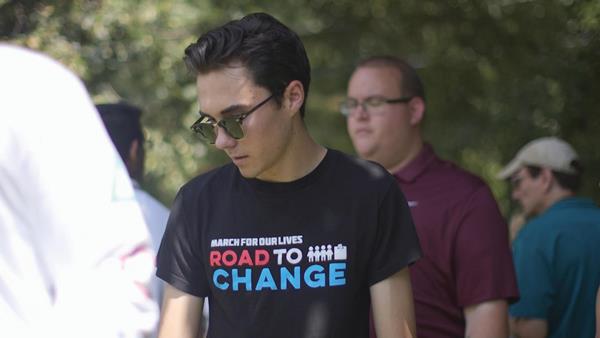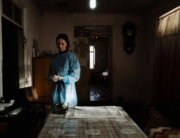
Emmanuel Durant Jr. in 1999, standing in front of the U.S. Capitol Building, 17 blocks from his home in Southeast Washington, DC (Davy Rothbart/Tribeca Film Festival)
Two of the more noteworthy documentaries at this year’s Tribeca Film Festival center on tragedy—each of a highly personal nature, although one has received considerable media attention. In both cases, they spotlight ordinary people attempting to build something positive in honor of those they have lost. These two films each have one public screening left at the festival this coming weekend, but will hopefully be making the festival rounds afterwards.
The gritty but illuminating 17 Blocks centers on multiple generations of an African American family living in an underserved, crime-ridden section of Washington, DC, over a span of 20 years. We first meet the Sanfords in 1999, when matriarch Cheryl is a struggling single mother to three kids: a teenage daughter and two sons, the youngest of whom is nine-year-old Emmanuel. From the start, the precocious Emmanuel uses a camera given to him by director Davy Rothbart to chronicle day-to-day life. The resultant grainy footage, which captures random violence on the streets as well as the family’s troubled home life, feels all too raw and personal at times.
What holds the first half together for the most part is Emmanuel, who grows up before our eyes a bit rattled but largely intact thanks to his older brother Smurf, who tries to shield him from thug life while falling further into it himself. By age 19, Emmanuel seems poised to making something out of his life, and while the other Sanfords are doing less well, they rally around him—which makes the sudden narrative twist all the more heartbreaking. It’s a loss that leaves the rest of the family broken, and yet they must find a way to go on. From here on out, 17 Blocks is riveting as the Sandfords go through various stages of grief including anger and increasingly self-destructive behavior.
Rothbart takes a vérité approach, often a fly on the wall as family members admit to the demons haunting them. Meanwhile, thanks to the film’s two decades-long canvas, we stay embedded among the Sanfords long enough to see them turn back from the abyss, a process that feels well-earned. Along the way, through intimate, one-on-one conversations, we also get a fuller picture of how forces beyond their control derailed this once-thriving, middle-class family. Rothbart does an excellent job in humanizing his protagonists, especially the drug-addicted mother and dealer Smurf, to the point that we hope they can reclaim their lives. Despite moments of genuine despair, the film reveals how time—and its passage—may not heal all wounds but makes it possible to feel hope again.

Marjory Stoneman Douglas student and activist David Hogg attends a voter registration rally in New Jersey [Evan Simon/Tribeca Film Festival]
The moving After Parkland takes an equally up close and personal look at tragedy, revisiting the Marjory Stoneman Douglas High School shooting from the perspective of those who were there the day when 17 students were murdered. Between the sharing of first-hand experiences, as well as actual cell phone camera footage taken by students as they were running for cover, we learn how terrifying it was to live through the event. But what also comes across is the anger and outrage of the Parkland community, stirred up by what many of them view as a situation that’s become all too familiar in America.
Directors Emily Taguchi and Jake Lefferman follow a diverse cross-section of Parkland residents, all of whom have a connection to the shooting, as they rise up and speak out. What makes their responses especially compelling is how they are not always the same. While students such as David Hogg call for stricter gun laws, others like Andrew Pollack, whose daughter Meadow was killed by the gunman, demand more resources for school safety instead. We also hear from survivor Victoria Gonzalez, whose boyfriend Joaquin was among the victims, who is simply trying to live her life despite the profound feeling of loss hanging over her. The filmmakers divide their time equally between their subjects, respecting everybody’s right to process in their own way, although depending on their politics, some viewers may find the reactions frustrating at times.
Some of After Parkland’s most compelling moments center on the re-opening of the school two weeks after the shooting. There is a massive police presence, which on the one hand represents a community coming together, but students such as Hogg claim they don’t actually feel safer, as nothing has been done legislatively to ban assault weapons. Their frustration leads to protests intended to keep the shooting on people’s minds, which eventually connect them to larger national movements to spur real change. But the filmmakers never lose sight of how the community of Parkland also needs to heal, and in one of the more poignant story lines, a recreational basketball team resumes its season in honor of a player who was among those shot.
At one point, there is a montage of students taking part in anti-gun walkouts at towns and cities across the country, and the sight of thousands gathered together to make their voices heard is undeniably powerful. No matter what your stance is on present-day gun laws, you’re likely to find much to admire in this portrait of resilience.






Leave A Comment